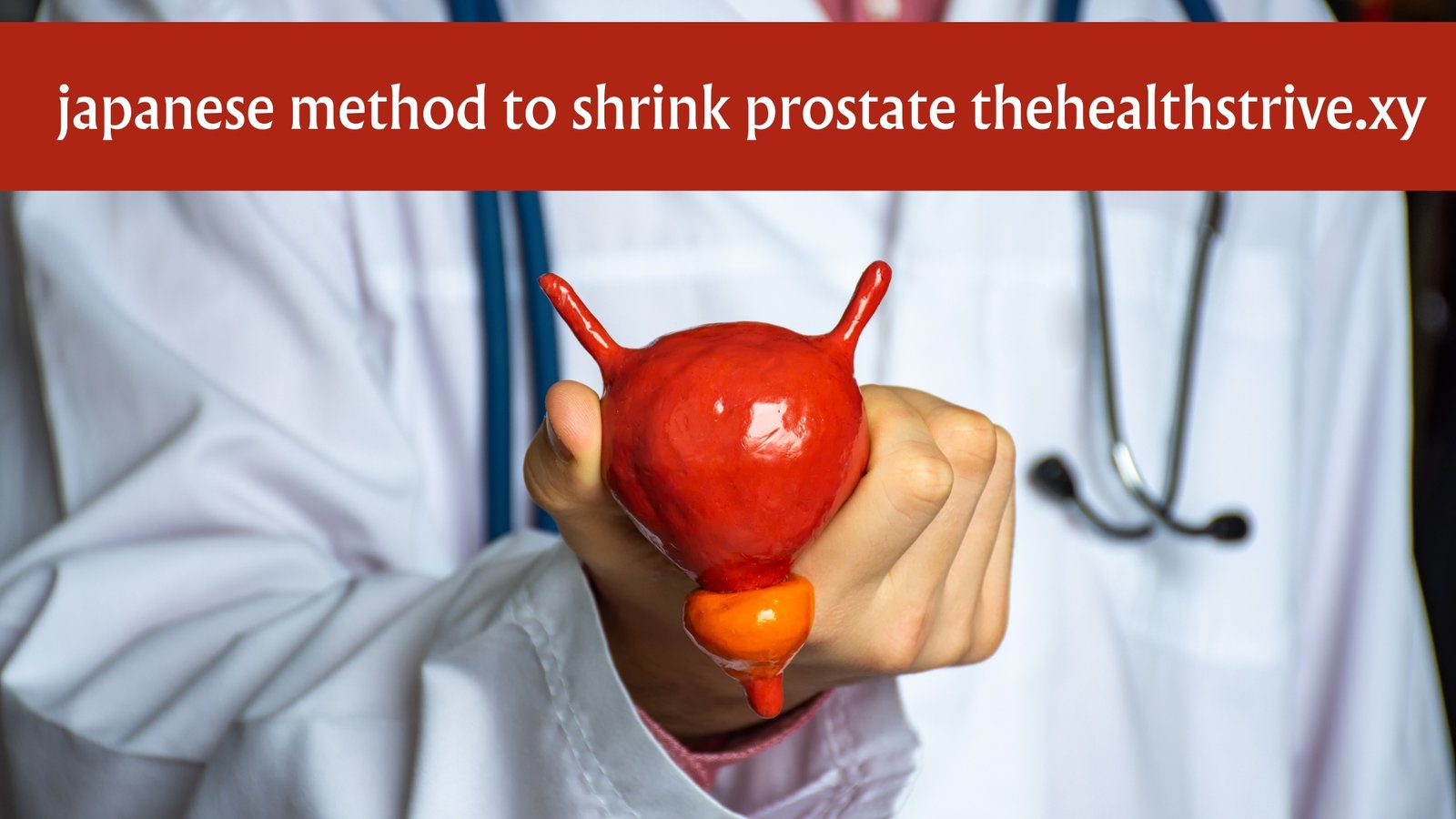Are you searching for a natural and effective way to support your prostate health? Look no further than the Japanese Method, a traditional approach that has been utilized for centuries to promote prostate wellness. In this blog post, we will explore how the Japanese method to shrink prostate thehealthstrive.xy gland naturally, its benefits, and step-by-step instructions on how to incorporate it into your daily routine. Say goodbye to worries about prostate health with this time-tested method!
Unveiling the Japanese Method
At the heart of the Japanese Method is a holistic strategy that targets the natural reduction of the prostate gland’s size. This method seamlessly integrates traditional practices with modern health principles, focusing on enhancing prostate health through lifestyle and dietary adjustments complemented by specific exercises. Passed down for generations, it stands on the belief that a balanced and mindful approach to daily living can significantly impact one’s prostate health.
Central to this method is the importance of a diet that emphasizes anti-inflammatory foods, an aspect that not only supports prostate wellness but also fosters overall health. The inclusion of physical activities tailored to improve circulation and reduce stress further distinguishes the Japanese Method. Unlike conventional methods that might focus solely on symptom management, this approach aims to address the underlying causes of prostate issues, promoting a holistic improvement in health.
By advocating for a comprehensive lifestyle shift, the Japanese Method encourages individuals to take proactive steps towards managing their prostate health. The focus is on prevention and the cultivation of habits that contribute to a healthy prostate gland. This method is a testament to the power of traditional wisdom combined with contemporary health practices, offering a sustainable path to wellness.
How Does the Japanese Method Work?
The essence of the Japanese Method in promoting prostate health lies in its multi-faceted approach, which holistically targets the factors contributing to prostate enlargement. This methodology is not a quick fix but rather a lifestyle overhaul that emphasizes the power of preventive care through natural means. By integrating dietary choices rich in anti-inflammatory properties, engaging in regular physical exercises designed to enhance blood flow and reduce stress, and adopting habits that support overall well-being, this approach directly impacts the health of the prostate gland.
A critical aspect of how the Japanese Method works is its emphasis on dietary modification. Incorporating foods like green tea, which is known for its antioxidant properties, soy products that contain phytoestrogens, and tomatoes rich in lycopene, plays a significant role in managing inflammation—a key factor in prostate health. Additionally, the method advocates for the regular practice of exercises, particularly those that improve pelvic circulation, and the implementation of stress management techniques such as meditation, which together can mitigate factors that exacerbate prostate issues.
By focusing on creating a harmonious balance in one’s lifestyle, the Japanese Method works on the premise that a healthier overall body environment is conducive to optimal prostate function. This approach, steeped in centuries of tradition, leverages the natural synergy between diet, exercise, and mental health to support and maintain prostate wellness.
Key Components of the Japanese Method
Central to the Japanese Method’s success in supporting prostate health are several pivotal elements. At the forefront is the dietary focus on anti-inflammatory foods, which includes the consumption of green tea, tomatoes, and soy products. These specific foods have been selected for their proven benefits in reducing inflammation, a key contributor to prostate issues.
Another critical component is the emphasis on regular physical activity. Exercises that specifically improve pelvic blood flow are particularly endorsed, as they directly impact the health of the prostate gland by promoting optimal circulation. This facet of the method not only aids in reducing the size of the prostate but also enhances overall physical health.
Stress management also plays an integral role in the Japanese Method. Techniques such as meditation or yoga are encouraged to help mitigate stress levels, which can exacerbate prostate health issues. This focus on mental well-being is crucial in achieving a holistic improvement in health.
Lastly, maintaining adequate hydration is emphasized to support the body’s natural detoxification processes, further contributing to prostate health. By integrating these components into one’s lifestyle, the Japanese Method offers a comprehensive approach to not only maintaining but also improving prostate wellness.
Benefits Beyond Prostate Health
Adopting the Japanese Method for prostate health introduces a host of ancillary advantages that extend well beyond the primary focus of prostate wellness. Individuals who embrace this comprehensive approach often report a notable increase in their vitality and energy levels, which contributes to a more active and fulfilling lifestyle. The emphasis on anti-inflammatory foods and regular physical activity inherent in the Japanese Method not only supports the prostate but also plays a significant role in enhancing cardiovascular health. This improved heart health is a direct result of better diet and exercise practices, leading to decreased risks of heart-related conditions.
Furthermore, the method’s stress reduction techniques, such as meditation and yoga, offer profound benefits for mental well-being. Practitioners frequently observe improvements in their sleep quality, experiencing deeper and more restorative sleep cycles. This, in turn, boosts cognitive functions and mood, fostering a sense of overall well-being. The immune system also benefits from this holistic health approach. With reduced inflammation and stress, coupled with a nutrient-rich diet, the body is better equipped to fend off illnesses, enhancing the individual’s resilience against common diseases. Engaging in the Japanese Method thus opens the door to a multitude of health benefits that collectively improve one’s quality of life.
Step-by-Step Guide to Implementing the Japanese Method
Embarking on the journey to integrate the Japanese Method into your lifestyle begins with a mindful evaluation of your current habits. The first step is a dietary shift towards consuming more anti-inflammatory foods. Prioritize adding more green leafy vegetables, fatty fish such as salmon, and nuts like walnuts and almonds to your meals. These food choices are pivotal in managing inflammation, which plays a significant role in prostate health.
Next, incorporate specific physical activities into your routine that are designed to enhance pelvic blood flow. Simple exercises, such as brisk walking or pelvic floor exercises, can be highly effective. Consistency is key, so aim to make these activities a regular part of your day.
In addition to physical wellness, addressing mental health through stress reduction is crucial. Explore practices like meditation and yoga, which not only help in managing stress but also contribute to overall health and well-being. These practices can be integrated into your daily routine, even if only for a few minutes at a time.
Lastly, ensure you are drinking plenty of water throughout the day. Adequate hydration supports the body’s detoxification process and is essential for maintaining good health.
By methodically implementing these steps, you can begin to experience the benefits of the Japanese Method for prostate health and beyond. Remember, this is a lifestyle change that encourages overall wellness, so embrace each step with commitment and mindfulness.
Real-Life Success Stories
The transformative impact of the Japanese Method on individuals’ prostate health and overall wellness is well-documented through numerous personal accounts. Those who have adopted this holistic approach share compelling narratives of significant improvements not only in the symptoms associated with prostate enlargement but also in their general health and vitality. Stories of regained energy, reduced discomfort, and a renewed sense of well-being are common among practitioners. For example, one individual recounted how adopting the dietary changes recommended by the Japanese Method led to noticeable relief from previously persistent symptoms, allowing for a return to a more active and enjoyable lifestyle. Another shared the positive effects of integrating targeted physical exercises into their daily routine, emphasizing the reduced stress levels and enhanced quality of life they experienced. These success stories serve as powerful testimonials to the efficacy of the Japanese Method, offering inspiration and encouragement to others seeking natural and sustainable ways to manage their prostate health.
Must Read: 2131953663: The Mysterious Number Behind Deleted Comments
Precautions and Considerations
Before diving into the Japanese Method for enhancing prostate health, it’s critical to recognize the importance of individual health circumstances. Consulting with a healthcare professional is a step that cannot be overlooked. They can provide personalized advice, taking into account any existing health conditions or dietary needs that could influence the effectiveness of this approach. It’s also vital to be aware of how your body responds to the changes you make. Some adjustments might be necessary to align with your specific health requirements and goals. The transition to this holistic method should be a gradual process, allowing your body to adapt to the new dietary and lifestyle modifications. Remember, what works for one person may not work for another, so paying close attention to how you feel as you implement these changes is key. Ensuring these precautions are taken can help maximize the benefits of the Japanese Method, making it a positive experience towards achieving better prostate health and overall well-being.











Leave a Reply